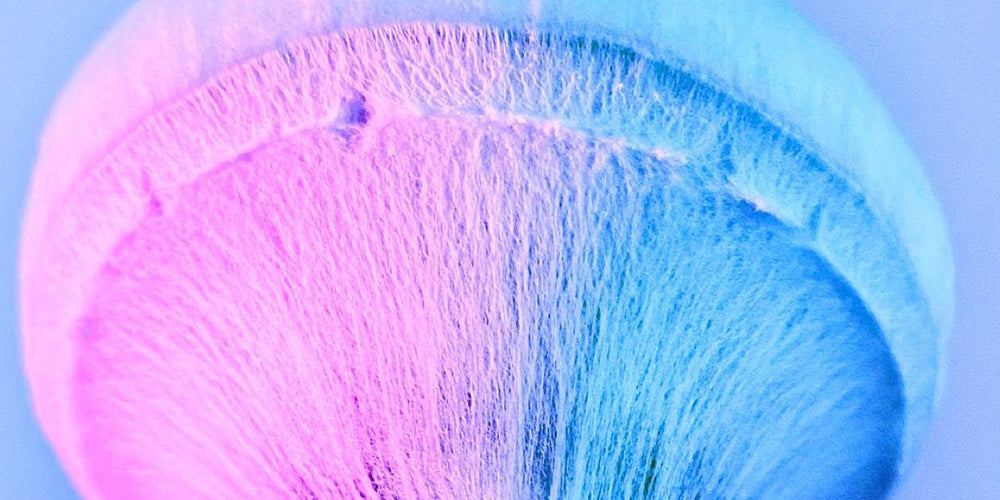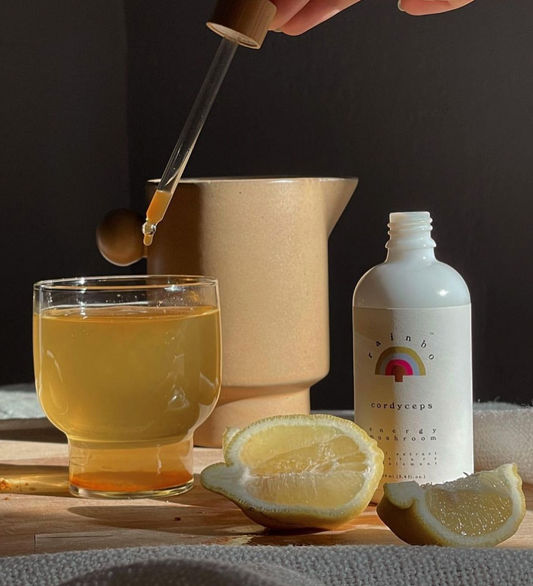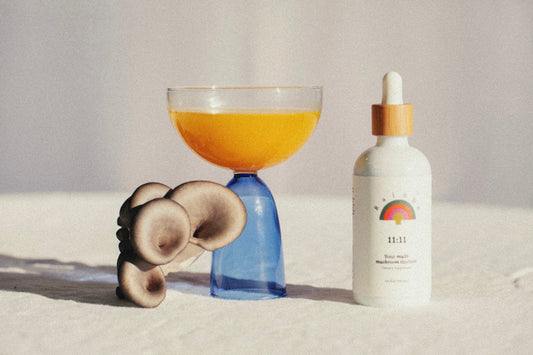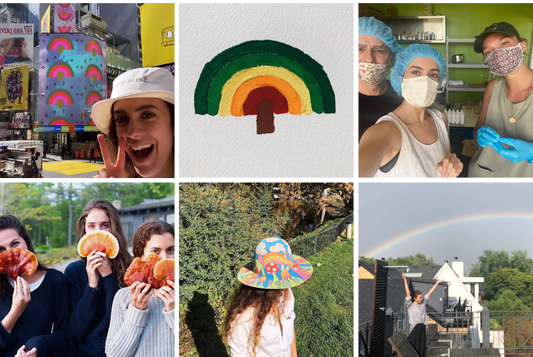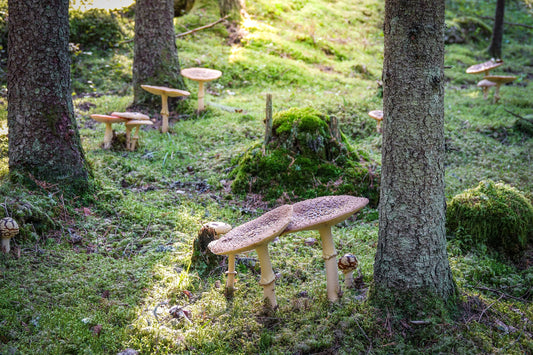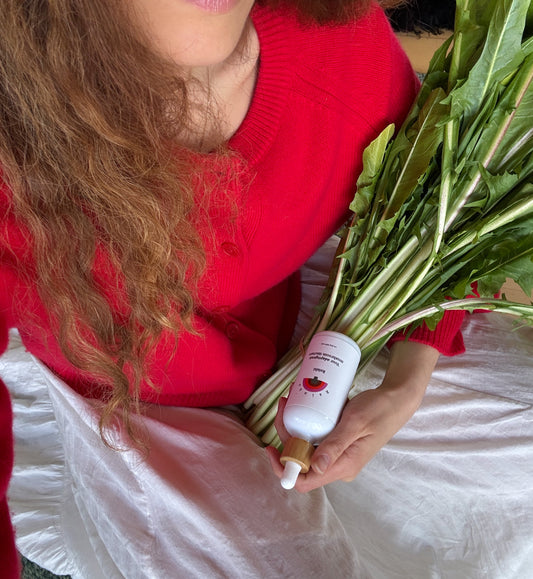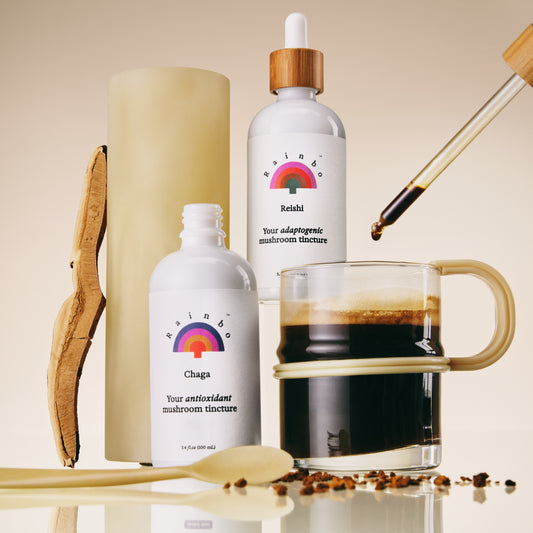Shrooms vs Mushrooms
Do medicinal mushrooms mean "shrooms"?
There is often a misconception that when we’re talking about medicinal mushrooms we’re talking about shrooms, the magical kind. However medicinal mushrooms do not always mean psychedelic mushrooms. While psychedelic mushrooms are gaining recognition in the psychiatric world for their therapeutic promise for those who live with Major Depressive Disorder or who battle addiction, they only make up a small branch of the medicinal mushroom world.
The world of medicinal mushrooms is vast, consisting of fungi that create penicillin and other antibiotics, culinary mushrooms such as shiitake, oyster, maitake, and lion’s mane, and thousands of other fungi with secondary metabolites that benefit us.
What are secondary metabolites?
Secondary metabolites are compounds that are not required for the normal growth and reproduction of an organism. Rather, they promote survival by giving the organism a competitive edge, for example in helping ward off predators. Oftentimes secondary metabolites are bioactive - they produce "biological - activity" in the organism consuming them.
For example, menthol, a secondary metabolite found in the mint family, is an antimicrobial agent that is often used in traditional medicine for throat irritation, nausea, and sunburns. Large amounts of menthol consumption by animals is very toxic, so this secondary metabolite keeps herbivores from eating the mint plant, aiding in its survival.
Another example of a secondary metabolite is penicillin from the fungi Penicillium. This compound prevents bacteria from overtaking the fungi. In addition to the creation of a revolutionary antibiotic, this genus of fungi also naturally produces bioactive compounds that have become key pharmaceuticals such as anti-fungal griseofulvin, the immunosuppressant mycophenolic acid, and the cholesterol lowering drug compactin/Mevastatin.

Many of our life-saving medicines are derived from the secondary metabolites of plants and fungi. Our *magical* ability to heal one another is based on our co-existence with nature.
Notably, as fungi are more closely related to humans than plants are, it is believed that fungi-derived medicines are a better fit for us than plant-derived drugs. Of course, plants and fungi did not evolve to create medicine for us. Rather, they evolved to survive their own predators, and the mechanisms (ie. secondary metabolites) in which they use to survive happen to benefit us as well.
We have coevolved with our environment, using plants and fungi as medicines before the era of synthetic chemicals and pharmaceuticals. Remarkably, we have receptors in our bodies that bind to nonhuman molecules such as carbohydrates, proteins, nucleic acids, and glucans from fungi, plants, and bacteria. The affinity of our innate receptors to foreign compounds is what allows the defence mechanisms of other organisms to have health enhancing effects in our bodies.
What makes mushrooms medicinal?
Most medicinal mushrooms are immunomodulating, meaning that when incorporated into our diets, they enhance our immune system. Depending on our bodies’ needs, mushrooms can down-regulate or up-regulate our immune response as well as support other areas such as gut health, stress management, and brain and nerve health.
More specifically, there are two active compounds found in medicinal mushrooms found in abundance: triterpenoids and beta-glucans. Triterpenoids are lipids (fats) found in higher-plants and fungi. They show a wide-range of biological activity such as anti-oxidative, anti-cancer, lipid-lowering, liver protective, anti-inflammatory, antimicrobial and wound healing capabilities, helping our bodies function at a higher potential.
Meanwhile, beta-glucans are polysaccharides (a form of carbohydrate made of sugars) found in the cell walls of mushrooms, mycelium, yeast, certain bacterial, and cereal grains. While not all beta-glucans have immunological activity (such as the ones found in cereal grains), the beta-glucans found in fungi do. When we consume fungi, the beta-glucans bind to receptors in our small intestine and unlock a chain reaction that stimulates the immune system by increasing immune cells and enhancing their ability to fight pathogens.
Not only do beta-glucans up-regulate the immune system, they also down-regulate an over-active immune system and reduce inflammation by increasing the level of anti-inflammatory chemicals in the body. By bi-directionally regulating our immune system, beta-glucans are essential to keep our bodies balanced and healthy.
Our ancestors have known about the healing properties of mushrooms, having used them for medicinal purposes since at least 3000 BCE. In fact, the use of fungi has traversed millennia, cultures, and continents. For example, Hippocrates, a Greek physician, classified the amadou mushroom (Fomes fomentarius) to have anti-inflammatory properties c. 450 BCE!
Over 1500 years later, during the Ming Dynasty (1268-1644 AD), shiitake mushrooms (Lentinula edodes) became used widespread as a tonic that counteracted everyday aches, pains, and fatigue associated with aging.
Meanwhile, across the Atlantic, the Aztecs called psilocybin mushrooms teonanacatl, which translates to “God’s flesh”. The connection to God and these mushrooms emphasizes the importance of these fungi in their culture, especially in religious and healing rituals.

Healer holding teonanacatl mushrooms, source: unknown
While all of the mushrooms mentioned above are considered medicinal, psilocybin or psychedelic mushrooms carry a stigma unlike the others. In fact, in many countries, these mushrooms are illegal and are classified as Schedule 1 drugs under the United Nations 1971 Convention on Psychotropic Substances, signifying that they have a high potential for abuse and serve no medical purpose. However, the long history of traditional use of these mushrooms and recent scientific studies prove otherwise.
So what makes mushrooms psychedelic?
Mushrooms are psychedelic when they contain secondary metabolites that are psychoactive, including psilocybin, psilocin, and baeocystin. There are more than 180 varieties of fungi that contain these compounds and are found all over the world from Alaska to Southern Chile to New Zealand and Australia to Europe, Siberia, and Southeast Asia.

Image source: Jochen Gartz and Georg Wiedemann
While the exact reason why fungi evolved to secrete these compounds is still unknown, one popular theory is that they may reduce the appetite of predatory insects. It's postulated that these chemicals will stop the insect from eating before they consume the entire mushroom. In other animals like ourselves, these chemicals manifest quite a profound altered state of consciousness.
What is psilocybin and how does it work?
Psilocybin is the most prevalent and stable psychoactive chemical found in psychedelic mushrooms. Albert Hofmann, the man who first synthesized LSD (lysergic acid diethylamide), isolated psilocybin in 1957 from Psilocybe mexicana mushrooms.
When ingested, psilocybin turns into psilocin in the body. Psilocin is able to cross the blood-brain-barrier and bind to serotonin receptors. This transiently causes the brain to deviate from its normal waking state. Neuronal avalanching is thought to occur bringing about a chain reaction of brain changes; the visual cortex increases in activity, resulting in changes of perception, while parts of the brain that are active during wakeful rest decrease in activity, resulting in a loss of ego.
In this psychedelic state, the neural connections in various parts of the brain are enhanced, leading to communication between regions of the brain that are usually compartmentalized. This novel synchronization of the brain is why people can have profound insight after consuming magic mushrooms and why these compounds may be healing for people who battle addiction, depression and PTSD.
 Image source: Beckley Foundation
Image source: Beckley Foundation
Bottom line:
Magic mushrooms are considered medicinal and have been used for millennia for their healing powers. However, magic mushrooms are one of many in the world of medicinal mushrooms. While medicinal mushrooms tap into secondary metabolites for their therapeutic properties, the secondary metabolites of most medicinal mushrooms are not psychoactive. Rather, plenty of mushrooms (including ones that you find at your local market) often help modulate the immune system to help you and your body reach its highest potential.
